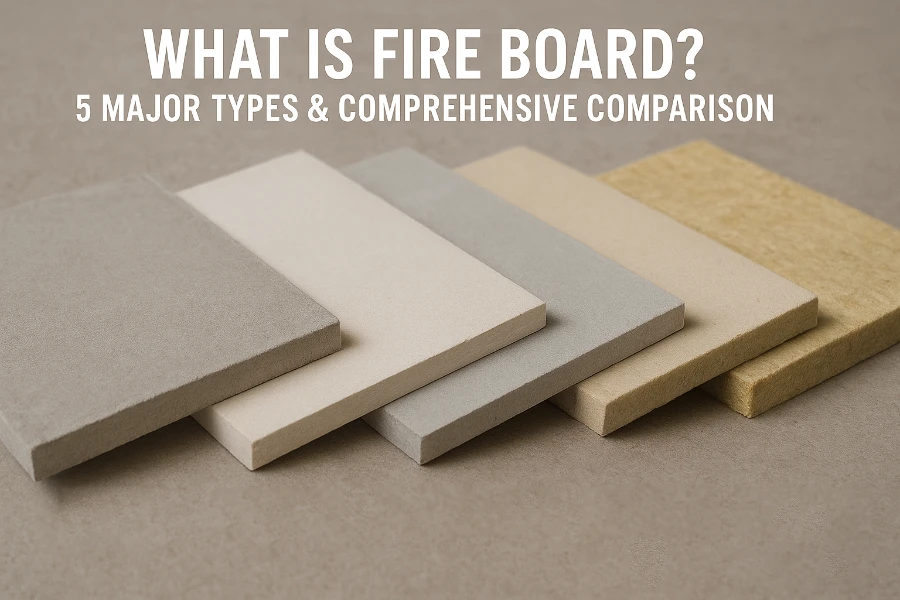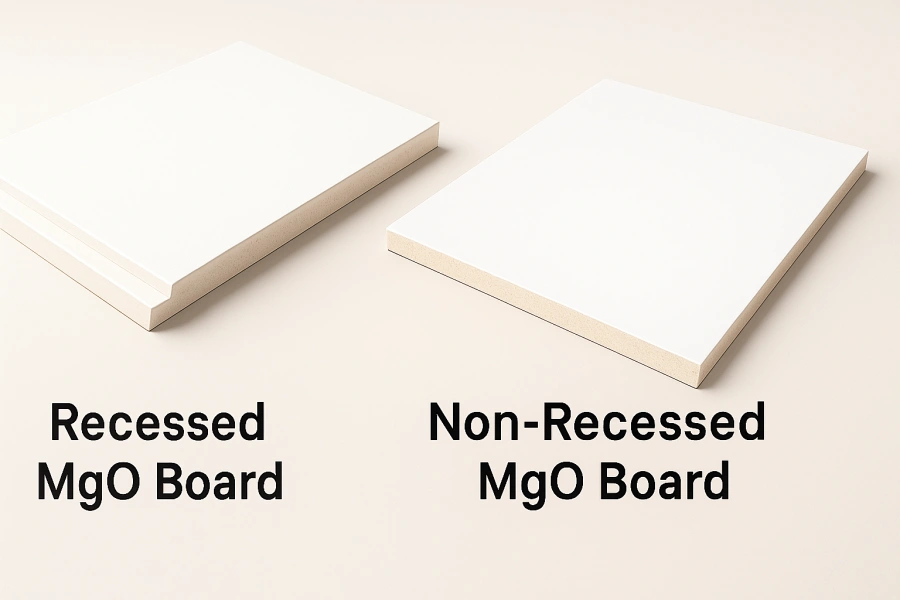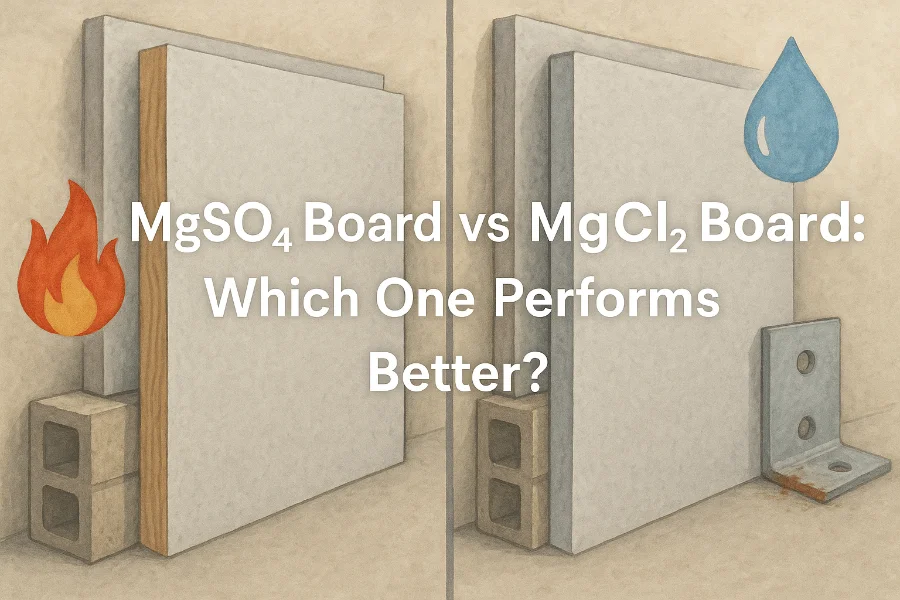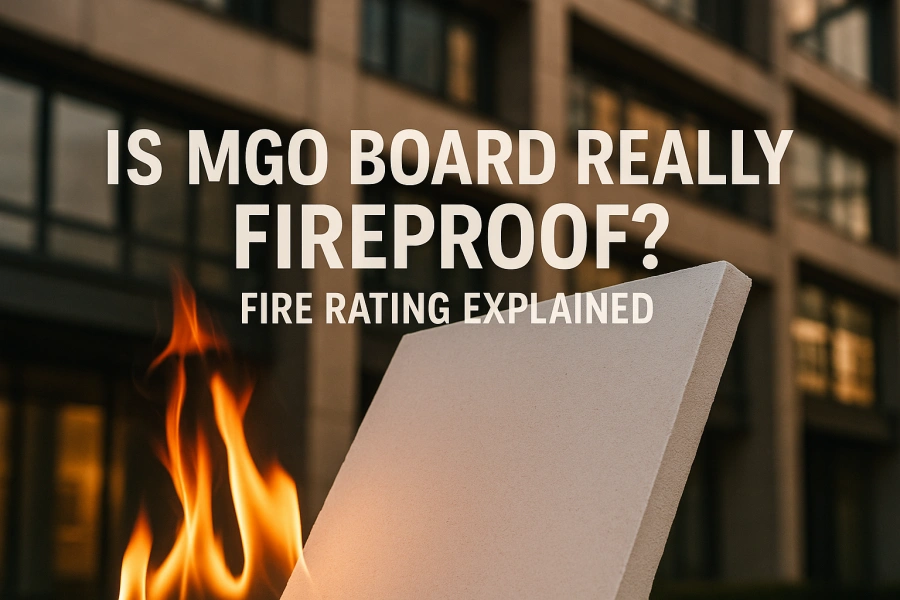Table of Contents
Ask Us Any Question
Introduction
In modern construction, fire safety has become a top priority. One of the essential materials used to enhance fire protection in buildings is fire board. But what exactly is a fire board, and why is it crucial for both residential and commercial projects?
This article aims to provide a clear introduction to fire boards, present the five major types, and offer a comprehensive comparison. By the end, you will have a better understanding of how each type performs and why some materials, like MgO board, stand out in terms of safety, durability, and sustainability.
What Is Fire Board?
A fire board is a type of building panel designed to resist fire and prevent the spread of flames in case of a fire. Unlike regular boards, fire boards are made from materials that can withstand high temperatures without losing structural integrity.
Fire boards play a crucial role in modern construction. They not only help protect property but also provide more time for occupants to evacuate during emergencies. Their performance is often measured by fire resistance ratings, which indicate how long a board can endure direct exposure to flames.
Compared to ordinary panels such as plywood or standard drywall, fire boards are engineered to offer superior fire resistance, better durability, and sometimes additional benefits like moisture resistance or environmental friendliness. Choosing the right type of fire board can significantly impact the safety and longevity of a building.
The 5 Major Types of Fire Board
1. Gypsum Board (Fire-Resistant Drywall)
Gypsum board, also known as fire-resistant drywall, is one of the most widely used fire boards in residential and commercial construction. It is made from a layer of gypsum sandwiched between paper facings. The key to its fire resistance is the water content in gypsum, which helps slow down heat transfer when exposed to fire.
Advantages of gypsum board include easy installation, smooth surface for finishing, and affordability. However, it is less durable under high moisture conditions and can sag or deteriorate if exposed to water for long periods. It is most commonly used for interior walls and ceilings where moderate fire protection is needed.
2. Calcium Silicate Board
Calcium silicate board is composed of silica, lime, and reinforcing fibers. It offers higher strength and better fire resistance compared to gypsum board. Calcium silicate boards also have excellent moisture resistance, making them suitable for areas where humidity may be an issue.
They are often used in industrial settings, commercial buildings, and areas that require a high degree of fire protection. On the downside, these boards are heavier and more difficult to cut and install than gypsum boards.
3. Fiber Cement Board
Fiber cement board is made by mixing cement with cellulose fibers or other reinforcing materials. It is highly durable, resistant to moisture, and maintains fire resistance over time. Fiber cement boards are suitable for both interior and exterior applications, including walls, ceilings, and facades.
Its advantages include long-term durability, resistance to rot and pests, and good structural integrity. However, fiber cement boards are relatively heavy and require more effort and skill to install compared to other types.
4. Mineral Wool Board
Mineral wool boards, sometimes called rock wool boards, are made from molten rock or slag spun into fibers. They have excellent fire resistance and thermal insulation properties, making them ideal for both fire protection and energy efficiency.
These boards are commonly used in ceilings, insulation layers, and areas where both fire resistance and soundproofing are important. One limitation is that mineral wool boards may produce dust during cutting and handling, requiring protective measures.
5. Magnesium Oxide Board (MgO Board)
Magnesium oxide board, or MgO board, is an environmentally friendly fire board made from natural magnesium compounds. It offers superior fire resistance, moisture resistance, and durability compared to most other boards. MgO board is also resistant to mold, mildew, and corrosion, which makes it a versatile choice for both interior and exterior applications.
In addition to fire safety, MgO boards are lightweight, easy to handle, and compatible with various finishing materials. These combined properties often make MgO board a preferred option in modern green building projects. Compared to gypsum, calcium silicate, fiber cement, or mineral wool boards, MgO board provides a balanced solution of safety, sustainability, and long-term performance.

Comprehensive Comparison of Fire Boards
When choosing the right fire board for a construction project, several factors need to be considered. These include fire resistance, moisture resistance, durability, environmental impact, and cost. The following comparison highlights how each type of board performs across these criteria.
Fire Resistance
Gypsum board offers basic fire protection suitable for moderate-risk areas. Calcium silicate and fiber cement boards provide higher resistance and can withstand more extreme conditions. Mineral wool boards are excellent in fire and heat insulation, while MgO board delivers superior fire resistance, often rated as non-combustible in most building codes.
Moisture and Durability
Gypsum board is sensitive to moisture and may degrade over time if exposed to water. Calcium silicate and fiber cement boards perform better in humid conditions, while mineral wool has moderate moisture resistance. MgO board stands out with excellent moisture resistance, mold-proof properties, and long-term durability, making it suitable for both wet and dry environments.
Environmental Impact
Gypsum and fiber cement boards involve some energy-intensive processes, whereas mineral wool and calcium silicate boards are moderately eco-friendly. MgO board is considered one of the most environmentally friendly options due to its natural composition and low emissions during production.
Cost and Installation
Gypsum board is the most economical and easy to install, which explains its popularity in residential projects. Calcium silicate, fiber cement, and mineral wool boards are heavier, require more skill to handle, and are comparatively costlier. MgO board, while slightly more expensive than gypsum, provides a balanced trade-off with its superior fire safety, durability, and environmental benefits, offering long-term value.
By considering these factors, it becomes clear that each fire board has its own strengths and limitations. For projects requiring a combination of safety, durability, and sustainability, MgO board often emerges as the optimal choice without compromising on performance.
Why MgO Board Stands Out
Among the various types of fire boards, MgO board consistently demonstrates a unique combination of properties that make it highly suitable for modern construction. Its natural composition ensures excellent fire resistance, often meeting the highest non-combustible standards. Unlike gypsum or fiber cement boards, MgO board maintains its strength even in humid conditions, resisting mold, mildew, and corrosion over time.
In addition to safety and durability, MgO board is environmentally friendly, made from naturally occurring magnesium compounds with minimal emissions during production. Its lightweight nature makes handling and installation easier, reducing labor costs and potential installation errors.
MgO board’s versatility also allows it to be used in a wide range of applications, from interior walls and ceilings to exterior cladding and specialized wet areas. For builders and designers seeking a balanced solution of fire safety, durability, and sustainability, MgO board offers a compelling advantage over other commonly used fire boards.
By considering both performance and long-term value, MgO board stands out as a reliable choice for projects aiming for safety, environmental responsibility, and lasting quality.
Conclusion
Fire boards play a crucial role in protecting buildings and their occupants from fire hazards. Understanding the different types, including gypsum, calcium silicate, fiber cement, mineral wool, and MgO boards, helps builders and designers make informed decisions based on safety, durability, and environmental considerations.
While each fire board has its strengths and ideal applications, MgO board stands out as a versatile and high-performance option. Its combination of superior fire resistance, moisture protection, durability, and eco-friendliness makes it suitable for a wide range of construction projects.
For anyone planning a construction project or seeking guidance on selecting the right fire board, exploring MgO board as a potential solution can offer long-term safety and value. To learn more about MgO board or discuss your specific project needs, feel free to contact our team of experts—we are ready to provide professional advice and support.
Compare recessed vs non-recessed MgO boards. Learn features, applications, and tips to choose the right fire- and moisture-resistant board.
Compare MgSO4 board vs MgCl2 board: discover key differences, performance, and durability to choose the best mgo board for your project.
Discover the fire rating and fire resistance of MGO board. Learn how this fire-rated magnesium oxide board protects buildings and ensures occupant safety.




